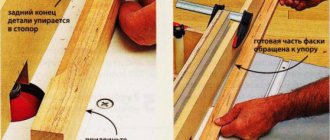how to make a hammock chair
Swinging in a hammock is the real embodiment of relaxation. A hanging hammock chair is a special type of hammock that enlivens our home or garden and simply makes life more exciting. And not to mention the health benefits. Did you know that a hanging chair strengthens the immune system, rejuvenates the brain and improves memory? Believe me, this is so, proven by science!
Some are scared by the possible difficulties in manufacturing and installation, but if you want to make a hammock chair with your own hands , then don’t worry, it’s even easier than putting together a simple stool. The article presents several simple examples with step-by-step photographs - look and be inspired.
How to hang
If there are trees at least 20 cm in diameter on the site, then you can hang a hammock from them. You can also attach one end to a tree and the other to a support.
The support should be made strong and deepened by at least a meter. If this is not possible, then you can buy a special support in the store, but it is not cheap. To install the supports yourself you will need:
- 2 beams for the base, 2.5 m long.
- 2 beams for posts 1.8 m long.
- 2 beams for cross support, 1.2 m long.
The posts are secured with self-tapping screws or bolts to the base. To add rigidity to the structure, special supports are attached to the end of the bases.
Hanging chairs on a frame
The frame for the chair can be made from different materials - it all depends on the intended shape of the product. And it can be either traditional rectangular or round. Of course, these are very conventional names, because a chair can resemble a hammock, an ordinary chair or a chaise longue, have a back and armrests, or look like a ball or cocoon.
For straight frame elements, wood is most often used, which must be sanded smooth and treated with impregnations that protect it from the sun, moisture and insects.
Wooden frame elements
The situation is a little more complicated with round elements, but they are most often the basis for hanging chairs. But nothing is impossible. If the household has a man, a welding machine and a pipe bending machine, you can make circles and ovals of any size and thickness.
Round steel frame
This option cannot be called a simple solution, and besides, it is not available to everyone. Therefore, a metal gymnastic hoop can be used as a frame. Or make it yourself from a large-section metal-plastic pipe. Thin pipes do not have sufficient strength.
Metal-plastic pipe
Such pipes are sold in spiral-coiled coils, so there will be no problems with giving them the desired shape. You can connect the ends of the pipe to close the ring using a wooden insert that fits tightly into its cavities. The insert is secured with self-tapping screws screwed into both sides of the joint.
Cutting the pipe into pieces of the required length
Connecting a pipe into a hoop
Returning to the welding option, we’ll take this opportunity and offer men a brutal model of a hanging chair that only they can make. To do this, you will need to weld a structure of several rings connected at the top point and diverging downwards.
At the bottom, a thick metal sheet is welded to the inner sides of the rings, and a wooden seat is placed on it, which, if desired, can be made soft by gluing foam rubber to it and covering it with leatherette.
Metal hanging chairs
Hanging cage chair made of metal
Hanging chair made of metal for the garden
Now that we’ve sorted out the materials for the frame, we can move on to the chairs themselves and the methods of their manufacture.
Hammock for sitting
The frame structure for this model is assembled from four straight parts. They can be wooden or metal - whichever you prefer.
Hammock for sitting
In total you need three thick strips and two thinner ones. It is better if they are round. You will also need a strong cord for weaving the seat and slings, a screwdriver with a drill equal to the diameter of the thin cuttings, and self-tapping screws.
Everything you need to make a hammock chair
Step 1. Drill two holes at the ends of two large-section cuttings. We insert thin cuttings into the outer ones and secure them with self-tapping screws. The frame for the chair is ready.
Making a wooden frame
Step 2. We hang the frame at a convenient height. We cut 16-20 pieces from the cord of such length that it is four times the height of the frame. You can make more sections depending on the desired weaving density. The main thing is that their number is a multiple of four. We fold them in half and hang them on the top part of the frame. We tie a flat knot on every four threads.
Weaving a hammock
Step 3. Under the first row of knots we knit a second one offset by two threads. Each odd row repeats the first row, each even row repeats the second row. In this way we knit the entire fabric, which should be 15-20 cm longer than the frame. This process will be shown in more detail in the video at the end of the master class.
Continuation of weaving
Step 4. We secure the ends of the threads to the lower part of the frame with strong knots and cut them evenly. The slings can be woven with continuous flat knots of four strands, or simply take a thicker and stronger rope.
Securing the ends of the threads
Step 5. We thread it through the holes on the frame and in the top bar, tying thick knots under them at the desired height. And we hang the hammock chair in a convenient place.
Hanging a hammock
Video - Macrame “Chess” from flat knots
Advice. For those who do not know how to weave, but love to sew, it will be easier to make a seat from durable fabric. To do this, you first need to thread the horizontal frame parts into the drawstrings on the seat, and then connect them with the transverse bars.
Wicker chair
Wicker chair
Using the macrame technique, you can make a more comfortable chair on a round frame, for the manufacture of which you will need the following tools and materials:
- two rings with a diameter of 100-110 cm and 65-70 cm. Large for the back, small for the seat;
- 900-1000 m of clothesline or polyamide cord 4-5 mm thick;
- rope or slings for hanging - about 12 meters;
- tape measure or tailor's tape measure;
- wooden plank along the height of the back;
- scissors.
Step 1. Cut the cord, the length of which should be 40 times longer than the circumference of the seat hoop. We fold it in half, hang it on the pipe, threading the ends into a loop, and wrap the hoop in tight turns in both directions. Having made several turns, we secure the cord by threading the end into the previous turn of the winding and tightening it. We braid the back frame in the same way.
Winding the cord
Step 2. Cut the cords for weaving the seat, their number should be a multiple of four. We hang them on half of the hoop with a double loop.
Weaving patterns
Step 3. Weave the mesh with flat knots, as described in the previous example. First, we tie a knot on the four middle threads from two adjacent hinges, then we connect two threads on each side to the weaving, gradually expanding it to the diameter. After “crossing the equator,” we tie the ends of the threads released from the weaving to the second half of the hoop.
Weaving a chair on a round frame
Step 4. We fasten the frames of the back and seat to each other, tightly wrapping them with a cord. To raise the backrest to the desired position, we temporarily install one or two wooden spacers in the rear of the frame.
Connecting frames
Step 5. We hang the cords on the upper part of the backrest and weave according to the already familiar pattern, tying the ends to the back of the seat. Together with those tied in front, they form a fringe around the entire circumference. If desired, it can be made thicker by hanging short pieces of cord in between. Once weaving is complete, the spacer can be removed.
The wooden spacer is removed after weaving is completed
The chair is ready, all that remains is to hang it using a braided cord or slings.
Note! The cord or rope for braiding should not be very smooth, otherwise the knots will slip and unravel.
Wicker chair with soft cushion
Wicker hanging hammock chair
Hanging hammock chair on one hoop
Video - Hanging chair hammock. Wicker swing
Armchair made of fabric and hoop
Hoops come in different diameters. Choose the appropriate size or make your own from a pipe, depending on who the chair is intended for. It can be used as a children's swing.
Armchair made of fabric and hoop
The fabric for the cover should be dense and not unravel when cut. You can take quilted lining fabric with synthetic padding. Its length and width should be half a meter larger than the diameter of the hoop, and two such cuts will be needed.
In addition to the basic materials, you will need something else:
- a zipper with a length no less than the diameter of the frame;
- slings, carabiners for hanging;
- padding polyester with a large canvas for the inside of the chair and strips for braiding the hoop;
- strips of fabric for a hoop;
- interlining or bias tape for processing cutouts;
- sewing supplies;
- marker.
| Step by step photos | Description |
Step 1 | Spread the fabric on a flat surface and place the hoop in the center. |
Step 2 | We mark a circle on the fabric with a radius 25 cm larger than the radius of the frame. This margin is necessary so that the fabric is not stretched over the hoop, but sag, creating a comfortable seat. |
Step 3 | We cut out two identical circles from fabric according to the markings. |
Step 4 | Fold one of the circles in half and cut into two parts along the fold line. |
Step 5 | We attach a zipper to the cuts, retreating from the edges by 25 cm, taken for reserve. That is, the lock should be exactly the diameter of the hoop. |
Step 6 | Further, if desired, each fabric circle is quilted with padding polyester, but you can do without soft padding. Then both pieces are folded facing each other and stitched in a circle. |
Step 7 | Unzip the zipper and turn the cover inside out. Fold it in four and iron the fold lines so that they become noticeable. From these lines we set angles of approximately 30 and 45 degrees in both directions, as shown in the diagram, and mark the points at which we need to make cuts for attaching the slings. |
Step 8 | We cut the fabric according to the markings at the marked points in the shape of the letter Y, bend the petals inward, glue them with non-woven fabric and stitch them. Or we make semicircular cutouts and finish them with bias tape. |
Step 9 | We wrap the hoop in strips of padding polyester for softness. The smaller the diameter of the frame, the more layers it is better to make. |
Step 10 | We cover the hoop with fabric over the winding. |
Step 11 | We insert the hoop into the case and fasten it with a zipper. |
Step 12 | We cut off the slings or ropes on which the chair will hang. We make two sections of different lengths. For example, 2 meters for the back and 2.5 meters for the front. But it’s better to try them on on the spot and decide on their length depending on the height of the attachment point. |
Step 13 | We fold the slings in half, fasten them with a loop on the hoop through the cutouts made in the case and tie the ends with a knot. |
If textile or canvas slings are chosen for hanging, their ends are folded and sewn to form a loop into which a carabiner is inserted. This method will allow you to remove the chair and bring it into the house in case of bad weather.
Sewing the sling
Advice. You can also buy ready-made slings with carabiners that can be adjusted in length.
Video – Hammock chair made of metal hoop
Let's get started
First, we cut 20 meters of rope for fasteners. We cut the rest into 6 meters into equal parts. Then we fasten each rope with a loop and a knot on the bar. Next we weave a hammock. The most suitable cell size, so as not to get confused and not fall through in the hammock while relaxing, is seven centimeters. Once you have finished the hammock, attach the ends of the cords with knots to the second plank and to both straps with fasteners.
Hammock Weaving Guide:
- Initially, you need to plan the size of the hammock. For example, its dimensions are 2.5 × 1 m. To do this, you need to knit a mesh, casting from 20 to 30 loops across the width. Remember, the thicker the rope, the fewer loops you need to cast.
- The process of knitting a hammock is reminiscent of making fabric. Knit the first row, turn the product wrong side out and knit the next one. Then turn over again and knit the third row, and continue in this way until the end.
- It is important to correctly calculate the remainder so that the knot is at the edge of the row and not in the middle. Knots can ruin the appearance of the hammock and cause inconvenience during use.
- When the mesh is ready, prepare the wooden planks. Make holes in the bars for fastening.
- Then, in order, you need to thread the loops from each row into the holes.
- Do this with all the holes and loops, attaching the second bar to the future hammock.
- Gather the free ends of the rope together, fold them into a ring shape, wrap them across and tighten. We repeat the same with the other side of the product.
- Thread the holder into the newly formed holes or a tight cord that will secure the hammock to the trees.
Article on the topic: Beading necklaces with patterns for beginners: ogalala with MK and video
The relaxation hammock is ready! A two-hour sleep in this bed completely restores a person after a hard week of work. In a suspended state, it is easier to relax and not take unpleasant little things to heart.
Here are a few photos showing hammock weaving patterns:
You can also watch the video collection for inspiration.
Securing the hammock in place
Typically, hanging beds in nature are attached to trees. If they are not nearby or the trunks are thin (diameter less than 15 cm), pillars are dug to a depth of at least 1 m. When selecting a place to mount the product, adhere to the following rule: add 0.3 m to the total length of the mesh and get the required distance between the trees. For example, if the hammock is 2.7 m long, then it is desirable to have 3 m between the trees (supports).
If the distance is smaller, the mesh is suspended higher. In addition, take into account its likely stretching during operation. If the stock is suspended from posts, it is convenient to use threaded hooks for fixation. Keep in mind the following consideration: the larger the hook, the more securely the product will be secured. The hook should be screwed in towards the direction of the slings; this approach will reduce the load on the metal.
You can hang a wicker bed in a city apartment, if you have:
- hammer drill;
- 2 anchor bolts 10x60 mm;
- concrete drills with a diameter of 5 mm;
- concrete drills with a diameter of 10 mm;
- ropes for fastening (if necessary);
- pliers, hammer, pencil.
The work order is as follows:
- Selecting a location, marking. A room width of at least 3 m is desirable; if the size increases to more than 4 m, additional ropes will be required for reliable fixation.
- Making holes, first with a drill of a smaller diameter, then with a larger one.
- Removing concrete chips from the resulting excavation.
- Installing an anchor bolt. If necessary, use a hammer.
- Tighten the nut clockwise (while holding the hook with pliers). You need to make every effort.
- Hanging a rope on a hook, tying a knot.
- Hooking a hammock hook onto a knot in a rope.
- Perform fastening operations for the other party.
Why not make a stand?
The presence of a stand (in other words, a stand for a hammock) will solve the problem of preserving tree bark and mobility. You can make a stand from scrap materials; its design is simple and does not require significant effort during assembly.
To build a rack you will need: wooden blocks with a cross-section of 80x80, a board 100x30, studs, nuts, washers, a grinder, a hacksaw or circular saw, stain, varnish, a drill, hooks.
The third version of the stand is a combination of the previous two. The main difference is the use of jibs to prevent the structure from swinging from side to side, which makes it more stable. These additional elements (jibs) use a 50x100 board; see the table below for the remaining dimensions of the parts used.
07.04.2017
no comments











